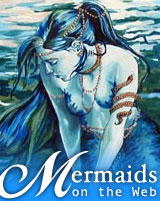
Selkies, Sirens and Others
About Selkies | Selkie literature and folktales | Sirens | Others
About Selkies
See also the family movie The Secret of Roan Inish.
A Home for Selkies. Detailed summary and links compiled by Beth Winegarner.
The Selkie Folk and Children of the Selkie Folk from Orkneyjar. Summary of Orkney Island lore relating to Selkie-folk—selkie simply means "seal" in Orkney—. Includes this useful bit of advice:
"Should such a mortal woman wish to make contact with a selkie man, there was a specific rite that she had to follow. At the high tide, the woman should make her way to the shore where she had to shed seven tears into the sea."This detail also caught my eye:
"The people of Orkney were so afraid of the attentions of the Selkie Folk that mothers would paint the sign of the cross on their daughters' breasts before they undertook a sea journey."Granted that this is what mothers told maiden daughters, it could also be aimed at less phocine attentions.
The Origin of the Selkie Folk. Five-part examination by Orkneyjar's Sigurd Towrie of the origin and meaning of Ornkey Selkie myths. 18–19c. Orcadians were split between three origins of the Selkie folk—souls of those drowned at sea; wrong-doers; and angels who fell in the sea.[1] Towrie explores the distinction between Selkies and Fin-Folk (the latter entirely malicious). Her derivation of Fin-folk from the "sorcerous" Finns (Saami ) of Norway is more persuasive than her attempt to integrate 17c. Inuit kayakers, whose low-vessels might inspire mermaid talk, and which, if left ashore, rendered them "human." This would, however, require the Irish merrows, whose magical red cap (cohuleen driuth) functioned just like the Selkie's skin, to be an even further development. The hunt for historical explanations of mythology is somewhat out of favor among academics today, although it remains a valid method. That said, this is an appealing and persuasive discussion, and Towrie can only be commended for trying to re-focus our sentimental perceptions:
"Outside the islands in recent years, helped along by the advent of the Internet, we have seen a transformation of the selkie folk into almost angelic spirits of the sea - something completely at odds to the terror and fear they once inspired in the people of Orkney."
Selchies. Summary and links from Paula Katherine Marmor's Legends.
Selkie Stuff from Selkie Sound. Selkie-philia.
Selkie literature and folktales
The Goodman of Wastness. Attractive Orkney Selkie tale distinguished by stretches of Orkey dialect (with translation), retold by Orkneyjar's Sigurd Towrie.
"The Children of the selkie folk" account collected by 19c. Orkney antiquarian Walter Traill Dennison, which ascribed a familial deformity to Selkie breeding, from Orkneyjar.
"One Spared to the Sea" Gentle Orkney tale told by W Towrie Cutt. Also here. The moral deserves repeating:
"One spared to the sea is three spared to the land."
"The Selkie that deud no' forget" in Dennison's Orkney and standard English. Similar to "One Spared to the Sea," except that this is a more-normal seal, not one of the "Seal folk." Orkney version also here.
The Seal-Woman's Croon (An Cadal Trom) from "Songs of the Hebrides"
"Sea Change" by Susan Stern. Poetry from a selkie POV.
"The Selkie" by Mara Freeman (1995), a Selkie-bride story. This version softens the husband's loneliness by having the half-Selkie children play with their seal mother. Courtesy Ms. Freeman's Celtic Spirit website. Also here.
"Sweetly the Waves Call to Me". Poetry by Pat Murphy (1990).
Excerpt from The Secret of Ron Mor Skerry by Rosalie K. Fry, the source of the movie.
"Part Thee and Me" by Beth Winegarner. Poem from selkie perspective.
Two variations of the ballad "The Great Selkie o' Suleskerry," in which a Selkie consorts with a woman to great tragedy, from Orkneyjar.
![]()
![]() Musical for Kids: A Selkie Tale, libretto by Peter Maxwell Davies, designed for seven and eight year olds. This page has video and audio of one such productions.
Musical for Kids: A Selkie Tale, libretto by Peter Maxwell Davies, designed for seven and eight year olds. This page has video and audio of one such productions.
Excerpt from "The Island of the Women" by George Mackay Brown.
Sirens
Lizard-siren illustration and text from the The Aberdeen Bestiary (c. 1200).
"In Arabia there are white snakes, with wings, called sirens, which cover the ground faster than horses, but are also said to fly. Their is poison is so strong that if you are bitten by it you die before you feel the pain."
The Suda, a Byzantine Encyclopedia, on the Sirens. The Suda goes with bird-woman combinations. The notes give citations in Homer, Apollonius Rhodius.
"Death's Sweet Call: Origin of the Siren Myth" by Antonio Lopez, on the psychology and gender politics of the Siren myth. The argument he cites on Greek and Latin spelling is rot.
Liza's "Song of the Sirens", with quotes from reference sources and images.
Excellent, hyperlinked, academic review of evidence from Carlos Parada's Greek Mythology Link. Good illustrations.
Encyclopedia Mythica: Sirens. Article by Micha F. Lindemans. Reviews classical evidence.
Others
The Sorcerous Finfolk by Orkneyjar's Sigurd Towrie. Multi-part exploration of the Orkney's "other" sea-people, the evil finfolk. For more background see Towrie's The Sea in Orkney Folklore, Monsters of the Deep. Lastly, if your interest in Orkney folklore extands past the shoreline, read The Folklore of the Orkney Islands.
Wikipedia: Lorelei. See also the German wikipedia page(translated into English).

"Blue Mermaid" above courtesy Tania Henderson, www.henderart.com.
All material © 2000–2004 Tim Spalding. Books presented in association with Amazon.com.
If you enjoy this site you may like this other site by me:
Seahorse and Sea Dragon Central. Comprehensive guide to seahorse and sea dragons.
Angels on the Web. Images and other web resources on angels in Western culture, religion and art.
Hammerhead Shark! Hammerheads in all their glory, with a picture galery.